Featured Resources
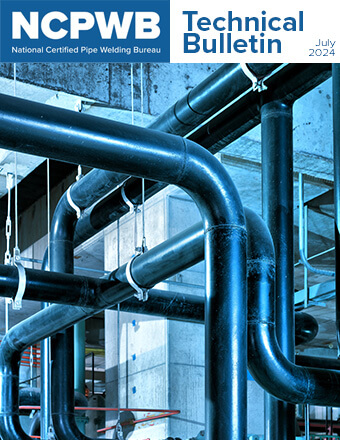
Piping codes are standard industry practice, and failure to agree on the one that applies to your work can result in ugly disputes with customers. Customer specifications can have inspection requirements that can result in repairs to welds that you did not plan for. Welders can make welds that put your business at risk. This article highlights what you can do to avoid these risks.
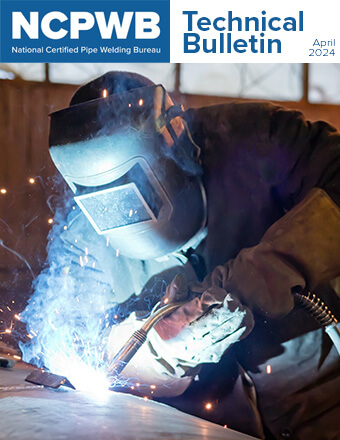
NCPWB Technical Bulletin: What You Should Understand About GMAW (MIG) & FCAW Welding
While there is a lot of buzz about modern waveform controlled power sources and how they make it easier for a welder to make the root pass, the basics of MIG welding have not changed. This article describes the technical aspects of GMAW, explains how the metal gets from the wire to the workpiece (transfer modes), and highlights what contractors need to pay attention to when bringing the process into their shop or field fabrication site.
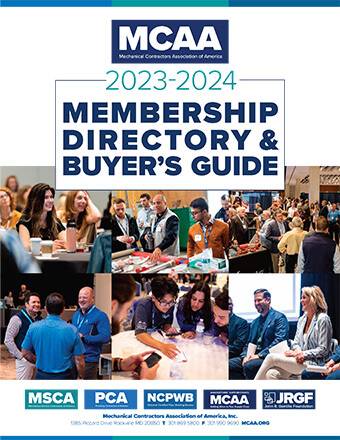
Membership Directory & Buyer’s Guide
This full-featured digital version of our Membership Directory & Buyer’s Guide enhances the look and feel of our printed directory with digital-only benefits.
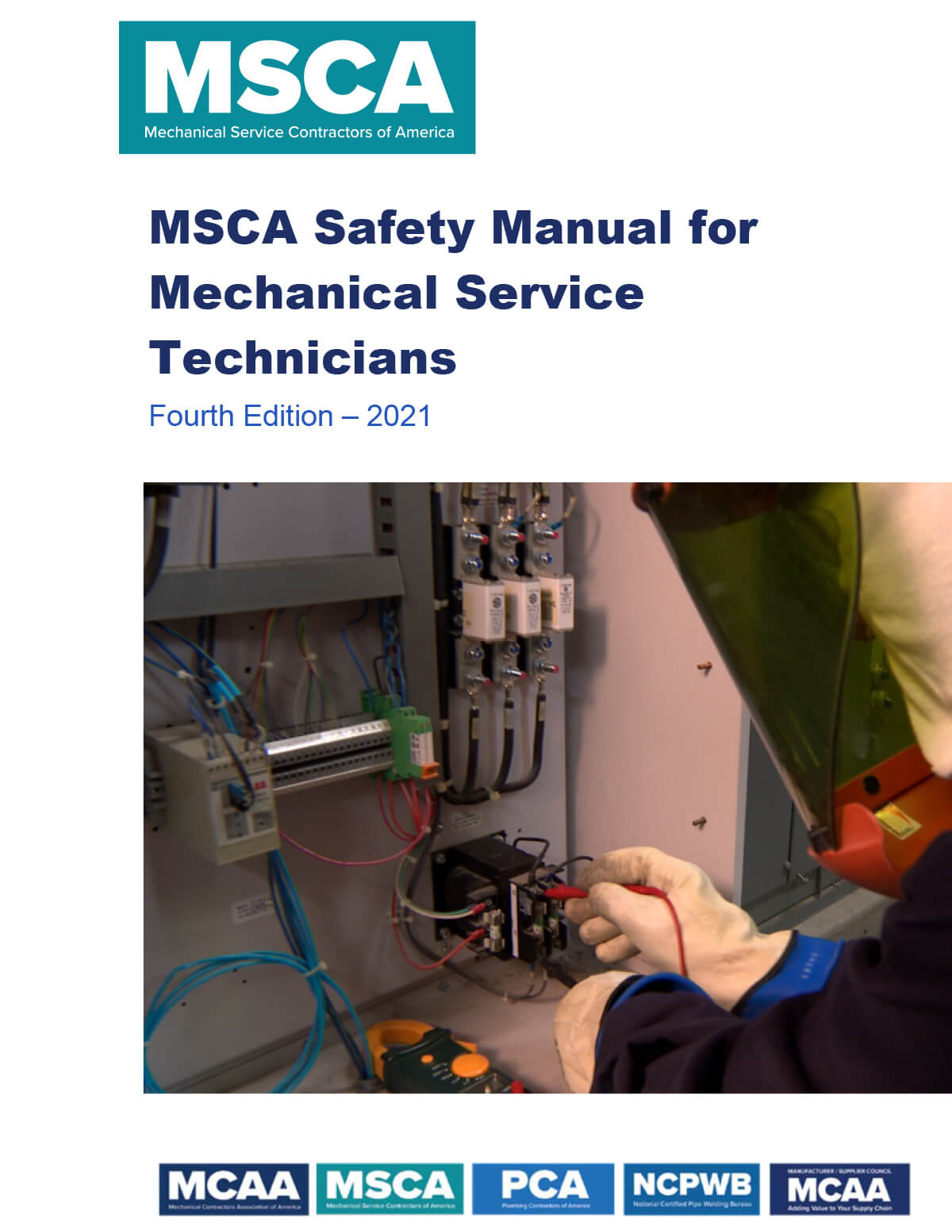
Safety Manual for Mechanical Service Technicians
This quick reference tool provides critical information on 84 safety and health topics that are specific to work performed by mechanical service technicians, including information on the newest and most frequently used refrigerants, substantive changes to NFPA 70E, and new information on how to properly administer CPR.
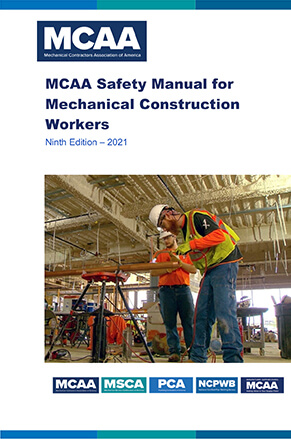
Safety Manual for Mechanical Construction Workers
This quick reference tool provides critical information on everything from aerial lift safety to preventing overexposure to zinc to keep mechanical construction workers safe. It includes new information on administering CPR, beryllium, recent changes to NFPA 70E, and more.
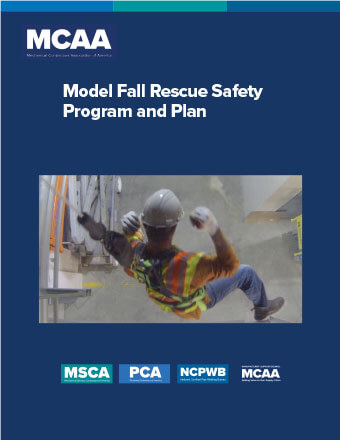
Model Fall Rescue Safety Program and Plan
Quick rescue is paramount to keeping workers safe while they are suspended in fall arrest harnesses after falling from an elevation. Having a safety program and plan in place to address the needs of these workers is critical to minimizing suspension trauma and meeting OSHA requirements. MCAA’s model program and accompanying model plan can be tailored to address various project fall arrest system applications and ensure the safety of your company’s most important asset, its workers.
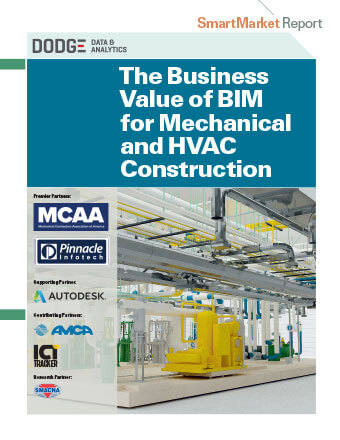
The Business Value of BIM for Mechanical and HVAC Construction SmartMarket Report
The use of BIM and related technologies and processes that leverage data from models is delivering meaningful impact to mechanical and HVAC contractors on a wide variety of measures, including cost and schedule improvements, enhanced productivity, better collaboration between stakeholders and better worker safety. This research report quantifies other benefits to users and the challenges related to leveraging BIM to increase industry understanding of which factors will most effectively drive growth and expand future use.
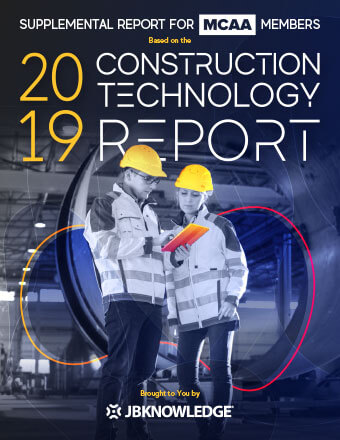
2019 Construction Technology Report Supplemental Report for MCAA Members
In addition to its annual report on construction technology practices from across the construction industry, JB Knowledge, MCAA’s construction technology research partner, provides a supplemental report specifically for MCAA members.
Latest Resources

Piping codes are standard industry practice, and failure to agree on the one that applies to your work can result in ugly disputes with customers. Customer specifications can have inspection requirements that can result in repairs to welds that you did not plan for. Welders can make welds that put your business at risk. This article highlights what you can do to avoid these risks.

NCPWB Technical Bulletin: What You Should Understand About GMAW (MIG) & FCAW Welding
While there is a lot of buzz about modern waveform controlled power sources and how they make it easier for a welder to make the root pass, the basics of MIG welding have not changed. This article describes the technical aspects of GMAW, explains how the metal gets from the wire to the workpiece (transfer modes), and highlights what contractors need to pay attention to when bringing the process into their shop or field fabrication site.
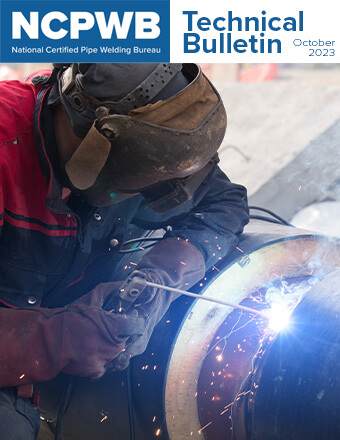
NCPWB Technical Bulletin: The 37-1/2 Bevel
The 37-1/2°± 2-1/2° bevel is the normal bevel angle to find on piping fittings and flanges and in many specifications and standards. Where did such a weird angle originate?
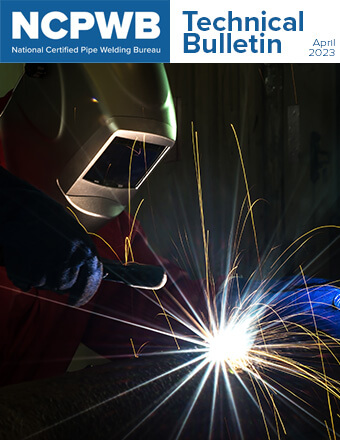
NCPWB Technical Bulletin: The Difference Between NCPWB WPSs and AWS Standard Welding Procedures
This bulletin explains how the National Certified Pipe Welding Bureau (NCPWB) Welding Procedure Specifications (WPSs) differ from the American Welding Society (AWS) Standard Welding Procedures in both application and adoption.
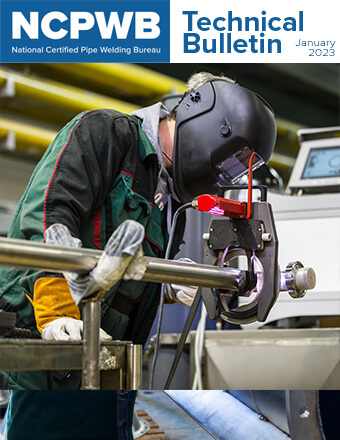
NCPWB Technical Bulletin: Qualification of Welding Operators for Orbital TIG Welding
There is occasional confusion among NCPWB members who use orbital pipe and tube welding machines when it comes to determining just what is required to qualify a welding operator and how to properly complete the QW-484 form for welding operators. This bulletin clarifies the difference between a welder and a welding operator and provides sample welder qualification test records for welding operators using automatic and machine welding.
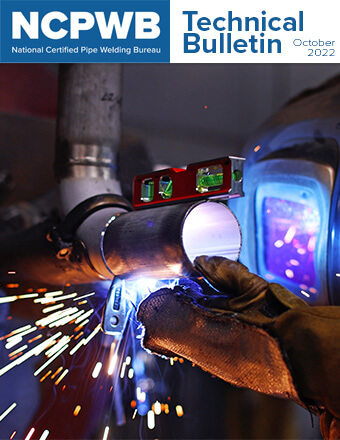
NCPWB Technical Bulletin: Welding Fumes
This bulletin explains how to protect welders from exposure to welding fumes and minimize health risks.
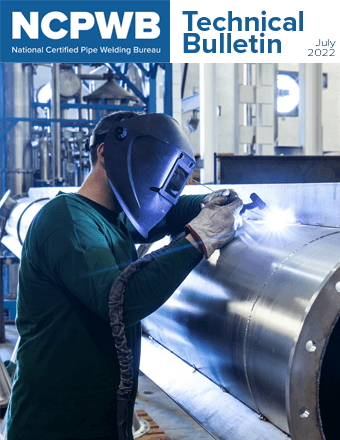
NCPWB Technical Bulletin: Range Qualified Column on Welder Qualification Record – What Does It Mean?
The most misleading statement in the welding industry is that a welder is qualified to follow a Welding Procedure Specification (WPS). A welder is qualified to use a welding process, not a WPS. This article explains what welders are allowed to weld in production based on the test conditions.
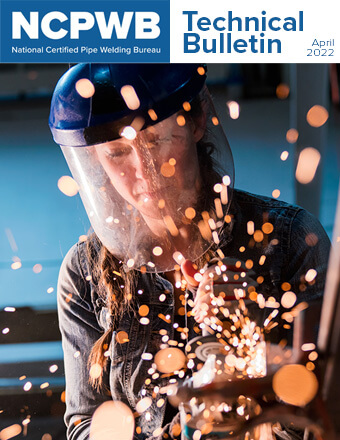
How to determine the number of test coupons required to meet the minimum weld length for radiographic examination under ASME Section IX.
Safety Resources
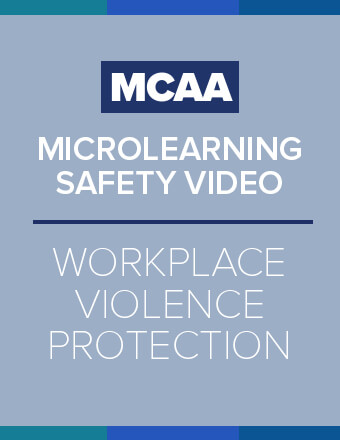
MCAA MICROLEARNING SAFETY VIDEO: Workplace Violence Protection – Spanish
MCAA believes the timing is right to release a microlearning safety video on Workplace Violence Protection. This stand-alone microlearning safety video highlights the vital course of action to protect yourself and your co-workers in the event of a workplace violence incident, such as an active shooter. This video is also available in English.
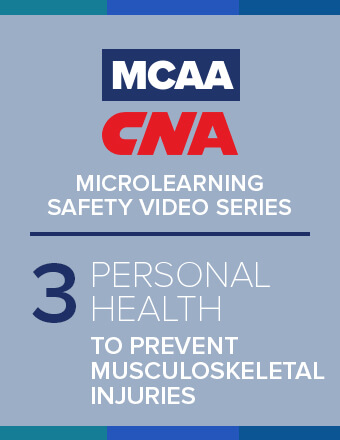
MCAA/CNA MICROLEARNING SAFETY VIDEO SERIES: Worker Personal Health – Spanish
Together with our partners in safety, CNA, MCAA developed the MCAA/CNA Microlearning Safety Video Series, a series of easy-to-watch safety videos that are under 3-minutes long. Please enjoy our third microlearning video on Worker Personal Health to Help Prevent Musculoskeletal Injuries. This video is also available in English.
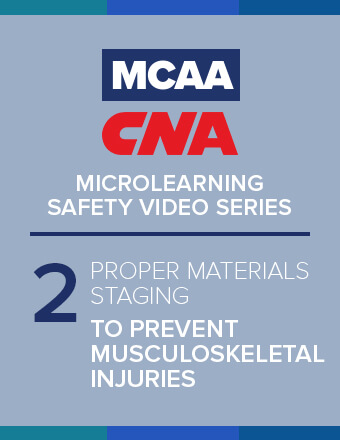
MCAA/CNA MICROLEARNING SAFETY VIDEO SERIES: Proper Material Staging – Spanish
Together with our partners in safety, CNA, MCAA developed the MCAA/CNA Microlearning Safety Video Series, a series of easy-to-watch safety videos that are under 3-minutes long. Please enjoy our second microlearning on Proper Materials Staging to Help Prevent Musculoskeletal Injuries. This video is also available in English.
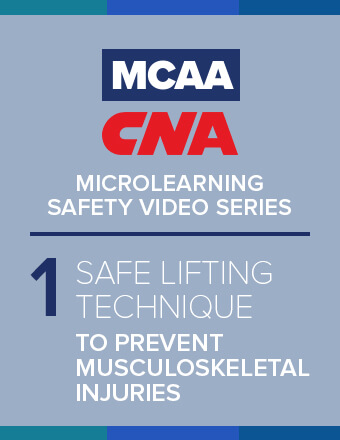
Together with our partners in safety, CNA, MCAA developed the MCAA/CNA Microlearning Safety Video Series, a series of easy-to-watch safety videos that are under 3-minutes long. Please enjoy our first microlearning video on Safe Lifting Technique to Help Prevent Musculoskeletal Injuries. This video is also available in English.
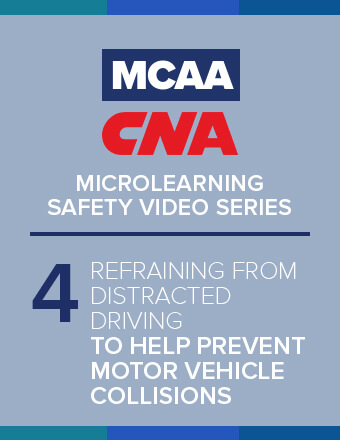
MCAA/CNA MICROLEARNING SAFETY VIDEO SERIES: Refraining from Distracted Driving – Spanish
Together with our partners in safety, CNA, MCAA developed the MCAA/CNA Microlearning Safety Video Series, a series of easy-to-watch safety videos that are under 3-minutes long. Please enjoy our fourth microlearning video on Refraining from Distracted Driving to Help Prevent Motor Vehicle Collisions. This video is also available in English.
Mental Health Awareness & Suicide Prevention Video – Spanish
Our newest safety and health video highlights the success story of an industry veteran, with appearances from MCAA’s president Robert Beck, the UA’s Jen Massey, industry expert Dr. Sally Spencer Thomas, and MCAA member Ricky Reams.
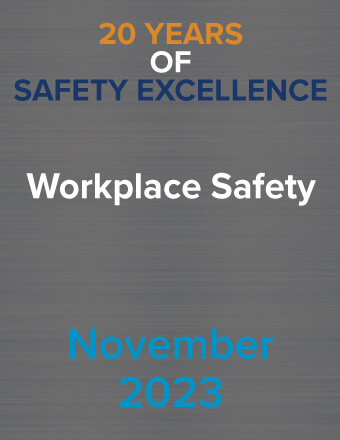
20 Years of Safety Excellence – November 2023: Workplace Safety
Workplace safety includes more than PPE and fall protection, it encompasses workplace distractions and workplace violence. Identifying warning signs and taking appropriate actions to prevent workplace violence is important to everyone’s safety and health. These resources show viewers how to protect themselves and others if they find themselves in an active workplace violence situation. This month’s kit includes two full length videos on workplace distractions and workplace violence and a microlearning series on workplace violence protection.
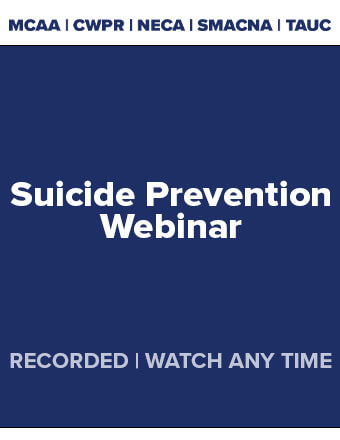
MCAA & Alliance Partners Suicide Prevention Webinar
Studies show that suicide is killing workers in the construction industry at five times the rate of work-related injuries like falls and struck-by incidents. And it’s killing them in all parts of the industry – including upper management. Unfortunately, there is no simple answer to why this is happening nor is there an easy fix, but in many cases deaths from suicide CAN be prevented when we push mental health stigma aside and help one another. MCAA and our Alliance partners explored the topic during a September 13, 2023, webinar. This is one recording you won’t want to miss – you could help save a life!